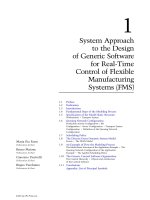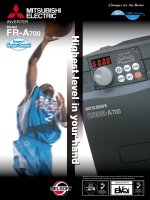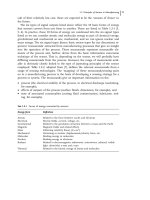Tài liệu Sensors in Manufacturing (P1) docx
Bạn đang xem bản rút gọn của tài liệu. Xem và tải ngay bản đầy đủ của tài liệu tại đây (402.54 KB, 30 trang )
Sensors Applications
Volume 1
Sensors in Manufacturing
Sensors in Manufacturing. Edited by H. K. Tönshoff, I. Inasaki
Copyright © 2001 Wiley-VCH Verlag GmbH
ISBNs: 3-527-29558-5 (Hardcover); 3-527-60002-7 (Electronic)
Sensors Applications
Upcoming volumes:
· Sensors in Intelligent Buildings
· Sensors in Medicine and Health Care
· Sensors in Automotive Technology
· Sensors in Aerospace Technology
· Sensors in Environmental Technology
· Sensors in Household Appliances
Related Wiley-VCH titles:
W. Göpel, J. Hesse, J. N. Zemel
Sensors Vol. 1–9
ISBN 3-527-26538-4
H. Baltes, W. Göpel, J. Hesse
Sensors Update
ISSN 1432-2404
Sensors in Manufacturing. Edited by H. K. Tönshoff, I. Inasaki
Copyright © 2001 Wiley-VCH Verlag GmbH
ISBNs: 3-527-29558-5 (Hardcover); 3-527-60002-7 (Electronic)
Edited by
H. K. Tönshoff, I. Inasaki
Series Editors:
J. Hesse, J.W. Gardner, W. Göpel
Sensors Applications
Volume 1
Sensors in Manufacturing
Weinheim – New York – Chichester – Brisbane – Singapore – Toronto
Sensors in Manufacturing. Edited by H. K. Tönshoff, I. Inasaki
Copyright © 2001 Wiley-VCH Verlag GmbH
ISBNs: 3-527-29558-5 (Hardcover); 3-527-60002-7 (Electronic)
Series Editors
Prof. Dr. J. Hesse
Carl Zeiss
Postfach 1380
73447 Oberkochen
Germany
Prof. J. W. Gardner
University of Warwick
Division of Electrical & Electronic Engineering
Coventry CV 7AL
United Kingdom
Prof. Dr. W. Göpel {
Institut für Physikalische
und Theoretische Chemie
Universität Tübingen
Auf der Morgenstelle 8
72076 Tübingen
Germany
Volume Editors
Prof. Dr. H. K. Tönshoff
Institut für Fertigungstechnik
und Spanende Werkzeugmaschinen
Universität Hannover
Schloßwender Str. 5
30159 Hannover
Germany
Prof. I. Inasaki
Faculty of Science & Technology
Keio University
3-14-1 Hiyoshi, Kohoku-ku
Yokohama-shi
Japan
Library of Congress Card No.: applied for
British Library Cataloguing-in-Publication Data:
A catalogue record for this book is available from
the British Library.
Die Deutsche Bibliothek – CIP-Cataloguing-in-
Publication Data
A catalogue record is available from Die Deutsche
Bibliothek
© WILEY-VCH Verlag GmbH
D-69469 Weinheim, 2001
All rights reserved (including those of translation
in other languages). No part of this book may be
reproduced in any form – by photoprinting, mi-
crofilm, or any other means – nor transmitted or
translated into machine language without written
permission from the publishers. Registered na-
mes, trademarks, etc. used in this book, even
when not specifically marked as such, are not to
be considered unprotected by law.
printed in the Federal Republic of Germany
printed on acid-free paper
Composition K+V Fotosatz GmbH,
D-64743 Beerfelden
Printing Betz-Druck, D-64291 Darmstadt
Bookbinding Wilhelm Osswald & Co.,
D-67433 Neustadt
ISBN 3-527-29558-5
n This book was carefully produced. Nevertheless,
authors, editors and publisher do not warrant the
information contained therein to be free of er-
rors. Readers are advised to keep in mind that
statements, data, illustrations, procedural details
or other items may inadvertently be inaccurate.
Sensors in Manufacturing. Edited by H. K. Tönshoff, I. Inasaki
Copyright © 2001 Wiley-VCH Verlag GmbH
ISBNs: 3-527-29558-5 (Hardcover); 3-527-60002-7 (Electronic)
As the use of microelectronics became increasingly indispensable in measure-
ment and control technology, so there was an increasing need for suitable sen-
sors. From the mid-Seventies onwards sensors technology developed by leaps and
bounds and within ten years had reached the point where it seemed desirable to
publish a survey of what had been achieved so far. At the request of publishers
WILEY-VCH, the task of editing was taken on by Wolfgang Göpel of the Univer-
sity of Tübingen (Germany), Joachim Hesse of Carl Zeiss (Germany) and Jay Ze-
mel of the University of Philadelphia (USA), and between 1989 and 1995 a series
called Sensors was published in 8 volumes covering the field to date. The material
was grouped and presented according to the underlying physical principles and
reflected the degree of maturity of the respective methods and products. It was
written primarily with researchers and design engineers in mind, and new devel-
opments have been published each year in one or two supplementary volumes
called Sensors Update.
Both the publishers and the series editors, however, were agreed from the start
that eventually sensor users would want to see publications only dealing with
their own specific technical or scientific fields. Sure enough, during the Nineties
we saw significant developments in applications for sensor technology, and it is
now an indispensable part of many industrial processes and systems. It is timely,
therefore, to launch a new series, Sensors Applications. WILEY-VCH again commis-
sioned Wolfgang Göpel and Joachim Hesse to plan the series, but sadly Wolfgang
Göpel suffered a fatal accident in June 1999 and did not live to see publication.
We are fortunate that Julian Gardner of the University of Warwick has been able
to take his place, but Wolfgang Göpel remains a co-editor posthumously and will
not be forgotten.
The series of Sensors Applications will deal with the use of sensors in the key
technical and economic sectors and systems: Sensors in Manufacturing, Intelligent
Buildings, Medicine and Health Care, Automotive Technology, Aerospace Technology,
Environmental Technology and Household Appliances. Each volume will be edited by
specialists in the field. Individual volumes may differ in certain respects as dic-
tated by the topic, but the emphasis in each case will be on the process or system
in question: which sensor is used, where, how and why, and exactly what the ben-
efits are to the user. The process or system itself will of course be outlined and
V
Preface to the Series
Sensors in Manufacturing. Edited by H. K. Tönshoff, I. Inasaki
Copyright © 2001 Wiley-VCH Verlag GmbH
ISBNs: 3-527-29558-5 (Hardcover); 3-527-60002-7 (Electronic)
the volume will close with a look ahead to likely developments and applications in
the future. Actual sensor functions will only be described where it seems neces-
sary for an understanding of how they relate to the process or system. The basic
principles can always be found in the earlier series of Sensors and Sensors Update.
The series editors would like to express their warm appreciation in the col-
leagues who have contributed their expertise as volume editors or authors. We are
deeply indebted to the publisher and would like to thank in particular Dr. Peter
Gregory, Dr. Jörn Ritterbusch and Dr. Claudia Barzen for their constructive assis-
tance both with the editorial detail and the publishing venture in general. We
trust that our endeavors will meet with the reader’s approval.
Oberkochen and Conventry, November 2000 Joachim Hesse
Julian W. Gardner
Preface to the SeriesVI
Manufacturing technology has undergone significant developments over the last
decades aiming at improving precision and productivity. The development of nu-
merical control (NC) technology in 1952 made a significant contribution to meet-
ing these requirements. The practical application of NC machine tools have stim-
ulated technological developments that make the tools more intelligent, and al-
lows the machining process to be carried out with higher reliability. Today, thanks
to the significant developments in sensor and computer technologies, it can be
said that the necessary tools are available for achieving the adaptive control of
manufacturing processes, assisted by monitoring systems, which was a dream in
the 1950’s.
For the following reasons, monitoring technology with reliable sensors is be-
coming more and more important in modern manufacturing systems:
· Machine tools operate with speeds that do not allow manual intervention. How-
ever, collisions or process failures may cause significant damage.
· Manufacturing systems have become larger in scale, and monitoring of such
large-scale systems is already beyond the capability of human beings.
· Increase of labor costs and the shortage of skilled operators calls for operation
of the manufacturing system with minimum human intervention; this requires
the introduction of advanced monitoring systems.
· Ultra-precision manufacturing can only be achieved with the aid of advanced
metrology and process monitoring technology.
· The use of sophisticated machine tools requires the integration of monitoring
systems to prevent machine failure.
· Heavy-duty manufacturing processes with higher energy consumption should
be conducted with minimum human intervention, from the safety point of
view.
In addition,
· Environmental consciousness in the manufacturing of today requires monitor-
ing emissions from the process.
This book deals with monitoring technologies in various manufacturing pro-
cesses, and aims to provide the latest developments in those fields together with
VII
Preface to Volume 1 of “Sensors Applications”
the necessary principles behind these developments. We are convinced that the
readers of this book, both in research institutes and in industry, can obtain infor-
mation necessary for their research and developmental work.
The editors wish to thank the specialists who contributed their expertise and
forbearance during the various stages of preparation. In addition to the assistance
of the authors, we would like to thank the staff of Wiley-VCH for their support.
Hannover and Yokohama, November 2000 Hans Kurt Tönshoff
Ichiro Inasaki
VIII
Preface to Volume 1 of “Sensors Applications”
List of Contributors
XVII
1 Fundamentals
1
1.1
Roles of Sensors in Manufacturing and Application Range
1
I. Inasaki, H. K. Tönshoff
1.1.1
Manufacturing
1
1.1.2
Unit Processes in Manufacturing
2
1.1.3
Sensors
3
1.1.4
Needs and Roles of Monitoring Systems
4
1.1.5
Trends
5
1.1.6
References
6
1.2
Principles of Sensors for Manufacturing
6
D. Dornfeld
1.2.1
Introduction
6
1.2.2
Basic Sensor Classification
10
1.2.3
Basic Sensor Types
13
1.2.3.1
Mechanical Sensors
13
1.2.3.2
Thermal Sensors
17
1.2.3.3
Electrical Sensors
17
1.2.3.4
Magnetic Sensors
18
1.2.3.5
Radiant Sensors
18
1.2.3.6
Chemical Sensors
18
1.2.4
New Trends – Signal Processing and Decision Making
19
1.2.4.1
Background
19
1.2.4.2
Sensor Fusion
21
1.2.5
Summary
23
1.2.6
References
23
1.3
Sensors in Mechanical Manufacturing – Requirements, Demands,
Boundary Conditions, Signal Processing, Communication
24
T. Moriwaki
1.3.1
Introduction
24
1.3.2
Role of Sensors and Objectives of Sensing
24
1.3.3
Requirements for Sensors and Sensing Systems
27
IX
Contents
Sensors in Manufacturing. Edited by H. K. Tönshoff, I. Inasaki
Copyright © 2001 Wiley-VCH Verlag GmbH
ISBNs: 3-527-29558-5 (Hardcover); 3-527-60002-7 (Electronic)
1.3.4
Boundary Conditions
31
1.3.5
Signal Processing and Conversion
32
1.3.5.1
Analog Signal Processing
32
1.3.5.2
AD Conversion
34
1.3.5.3
Digital Signal Processing
36
1.3.6
Identification and Decision Making
39
1.3.6.1
Strategy of Identification and Decision Making
39
1.3.6.2
Pattern Recognition
40
1.3.6.3
Neural Networks
41
1.3.6.4
Fuzzy Reasoning
42
1.3.7
Communication and Transmission Techniques
43
1.3.8
Human-Machine Interfaces
44
1.3.9
References
45
2 Sensors for Machine Tools and Robots
47
H.K. Tönshoff
2.1
Position Measurement
47
2.2
Sensors for Orientation
58
2.3
Calibration of Machine Tools and Robots
60
2.4
Collision Detection
62
2.5
Machine Tool Monitoring and Diagnosis
65
2.6
References
70
3 Sensors for Workpieces
71
3.1
Macro-geometric Features
71
A. Weckenmann
3.1.1
Mechanical Measurement Methods
72
3.1.1.1
Calipers
72
3.1.1.2
Protractors
73
3.1.1.3
Micrometer Gages
73
3.1.1.4
Dial Gages
75
3.1.1.5
Dial Comparators
76
3.1.1.6
Lever-type Test Indicators
76
3.1.2
Electrical Measuring Methods
76
3.1.2.1
Resistive Displacement Sensors
77
3.1.2.2
Capacitive Displacement Sensors
77
3.1.2.3
Inductive Displacement Sensors
78
3.1.2.4
Magnetic Incremental Sensors
81
3.1.2.5
Capacitive Incremental Sensors
81
3.1.2.6
Inductive Incremental Sensors
82
3.1.3
Electromechanical Measuring Methods
83
3.1.3.1
Touch Trigger Probe
84
3.1.3.2
Continuous Measuring Probe System
84
3.1.4
Optoelectronic Measurement Methods
86
3.1.4.1
Incremental Methods
86
ContentsX
3.1.4.2
Absolute Measurement Methods
89
3.1.5
Optical Measuring Methods
90
3.1.5.1
Camera Metrology
90
3.1.5.2
Shadow Casting Methods
91
3.1.5.3
Point Triangulation
91
3.1.5.4
Light-section Method
92
3.1.5.5
Fringe Projection
93
3.1.5.6
Theodolite Measuring Systems
93
3.1.5.7
Photogrammetry
94
3.1.5.8
Interferometric Distance Measurement
94
3.1.5.9
Interferometric Form Testing
95
3.1.5.10
Autofocus Method
96
3.1.6
Pneumatic Measuring Systems
96
3.1.7
Further Reading
98
3.2
Micro-geometric Features
98
A. Weckenmann
3.2.1
Tactile Measuring Method
99
3.2.1.1
Reference Surface Tactile Probing System
100
3.2.1.2
Skidded System
100
3.2.1.3
Double Skidded System
101
3.2.2
Optical Measuring Methods
101
3.2.2.1
White Light Interferometry
102
3.2.2.2
Scattered Light Method
103
3.2.2.3
Speckle Correlation
104
3.2.2.4
Grazing Incidence X-ray Reflectrometry
105
3.2.3
Probe Measuring Methods
106
3.2.3.1
Scanning Electron Microscopy (SEM)
107
3.2.3.2
Scanning Tunneling Microscopy (STM)
108
3.2.3.3
Scanning Near-field Optical Microscopy (SNOM)
110
3.2.3.4
Scanning Capacitance Microscopy (SCM)
111
3.2.3.5
Scanning Thermal Microscopy (SThM)
111
3.2.3.6
Atomic Force Microscopy (AFM)
113
3.2.3.7
Magnetic Force Microscopy (MFM)
117
3.2.3.8
Lateral Force Microscopy (LFM)
118
3.2.3.9
Phase Detection Microscopy (PDM)
119
3.2.3.10
Force Modulation Microscopy (FMM)
120
3.2.3.11
Electric Force Microscopy (EFM)
121
3.2.3.12
Scanning Near-field Acoustic Microscopy (SNAM)
122
3.2.4
Further Reading
123
3.3
Sensors for Physical Properties
123
B. Karpuschewski
3.3.1
Introduction
123
3.3.2
Laboratory Reference Techniques
125
3.3.3
Sensors for Process Quantities
125
3.3.3.1
Force Sensors
126
Contents
XI
3.3.3.2
Power Sensors
128
3.3.3.3
Temperature Sensors
129
3.3.3.4
Acoustic Emission Sensors
131
3.3.4
Sensors for Tools
134
3.3.5
Sensors for Workpieces
136
3.3.5.1
Eddy-current Sensors
136
3.3.5.2
Micro-magnetic Sensors
137
3.3.6
References
141
4 Sensors for Process Monitoring
143
4.1
Casting and Powder Metallurgy
143
4.1.1
Casting
143
H. D. Haferkamp, M. Niemeyer, J. Weber
4.1.1.1
Introduction
143
4.1.1.2
Sensors with Melt Contact
145
4.1.1.3
Sensors without Melt Contact
149
4.1.1.4
Summary
157
4.1.1.5
References
157
4.1.2
Powder Metallurgy
159
R. Wertheim
4.1.2.1
Introduction
159
4.1.2.2
Mixing and Blending of Metal Powders
159
4.1.2.3
Compacting of Metal Powders
162
4.1.2.4
The Sintering Process
166
4.1.2.5
References
171
4.2
Metal Forming
172
E. Doege, F. Meiners, T. Mende, W. Strache, J. W. Yun
4.2.1
Sensors for the Punching Process
172
4.2.1.1
Sensors and Process Signals
173
4.2.1.2
Sensor Locations
174
4.2.1.3
Sensor Applications
176
4.2.2
Sensors for the Sheet Metal Forming Process
181
4.2.2.1
Deep Drawing Process and Signals
182
4.2.2.2
Material Properties
182
4.2.2.3
Lubrication
184
4.2.2.4
In-process Control for the Deep Drawing Process
186
4.2.3
Sensors for the Forging Process
191
4.2.3.1
Sensors Used in Forging Processes
191
4.2.3.2
Sensor Application and Boundaries
195
4.2.3.3
Typical Signals for Forces and Path
198
4.2.3.4
Process Monitoring
200
4.2.4
References
202
4.3
Cutting Processes
203
I. Inasaki, B. Karpuschewski, H.K. Tönshoff
4.3.1
Introduction
203
ContentsXII









